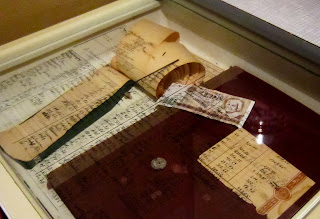I love ribs. Real ribs. Don’t bring anything like baby backs or other wanna be ribs. I am talking big spare ribs. So I bought 2 slabs of pork spare ribs and 1 slab of beef spare ribs for this occasion. I lathered them up with a good rub and let them sit in the fridge for around 24 hours before smoking. Then came Saturday morning. Everyone else still asleep from the previous nights festivities (and me still feeling the effects a little), I walked outside with my coffee and was greeted with that familiar fall crisp in the air. It wasn’t cold, but it wasn’t blazing hot either. I labored in front of the smoker for a few hours before everyone else “came to,” and people started arriving for the game. Here’s the result and how to get there:
Bar-b-q Spare Ribs
by: Ryan Burroughs
First make your rub. This can be any mixture, but it needs to at least have sugar (or something sugary), and spices. I don’t always (Read: I never) measure, but these are approximates.
Ryan’s Rib Rub
1/3 cup yellow mustard
½ cup brown sugar
2 tbs. Garlic powder
1 teaspoon ground Cayenne pepper
1 teaspoon Cumin
1 teaspoon Sweet Hungarian Paprika
1 tablespoon salt
1 tablespoon Black pepper
Mix the above together and brush liberally onto ribs. Wrap ribs in shrink wrap (or vacuum sealer bags if you have them) and seal them. Place in fridge overnight.
The next morning get up and make a nice hot pot of good coffee. Then get ready to make fire. I just use the old fashioned ECB Smoker. This is “El Cheapo Brinkman” to the lay person. They cost $40 at any hardware store and no man that enjoys preparing his meat outdoors like God and Bobby Flay intended should be without one. I won’t go into the details of smoker use, since this is an assumed instinct that all men (and, to be fair, many women) are blessed with. For ribs, I prefer a 50/50 mixture of apple wood and hickory wood chips, over lump charcoal. I find this a nice mild smoky flavor that doesn’t overpower the rib meat, and the lump coal burns very evenly with regards to temperature.
For ribs, rather than the internal temperature rules that apply to most smoking meats, I prefer the 3-2-1 method. I start coals and wood and smoke the ribs at 235 degrees. You will need a nice digital thermometer to read this temp. Make sure it doesn’t touch the meat or the grate to prevent misreads. You can cut the slabs in half to make them more manageable if you need to. I also have a rib rack that stands them vertically so I can fit 4-5 slabs of ribs (enough for around 10-12 people) in the smoker at once. I leave them in for three hours. Then I take them off and wrap them in foil. At this point you can either smoke or bake them (doesn’t matter since they’re wrapped and won’t absorb smoke) at 235 degrees for another 2 hours.
Now here comes the kicker and a slight variation of the ‘1’ part of the 3-2-1 Rule. Unwrap the ribs from the foil. What some people do at this point is put them back on the coals at 235 degrees for another hour. But what I do is put them on my grill and grill on medium-high (about 400 degrees) for about 10 minutes a side to firm the meat up a bit. The key? Brush them with some honey before hand. Sure, this doesn’t sound good. But it gets that nice bark that people love to see, and it cooks off so you can’t really taste it anyways. The result: No leftovers.
Ribs can also be paired with home made bar-b-q sauce for people that want to smother the flavor of all your hard work. While I hate the concept of bar-b-q sauce (because I really like the flavor of smoke and meat), I make a nice mild sauce that even I use on ribs. Just use it conservatively or you will just taste the sauce and none of the 6 hours of labor you just spent.
Fresh off the smoker...
Homemade Bar-b-q Sauce
½ cup Ketchup
2 Tablespoons yellow or spicy mustard
1/4 cup Brown Sugar
2 Tablespoons of Worchestershire (or Worsishishishisher sauce to most)
1 Tablespoon Apple Cider Vinegar
½ Teaspoon Cayenne Pepper
1 Teaspoon Salt
1 Teaspoon Ground Black Pepper
This can be mixed over low-medium heat. Another nice touch I have been experimenting with is to actually put it in the smoker (use a safe container that’s open) and smoke it too.
Enjoy!












